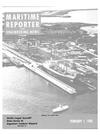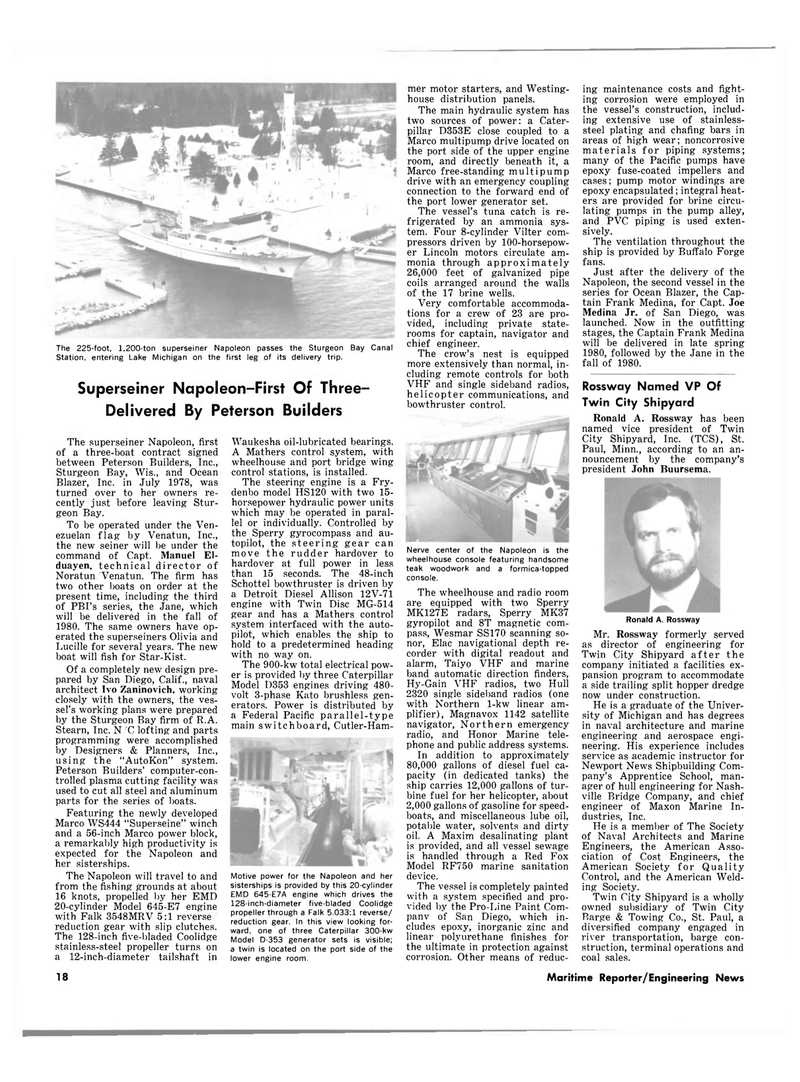
Page 16: of Maritime Reporter Magazine (February 1980)
Read this page in Pdf, Flash or Html5 edition of February 1980 Maritime Reporter Magazine
The 225-foot, 1,200-ton superseiner Napoleon passes the Sturgeon Bay Canal
Station, entering Lake Michigan on the first leg of its delivery trip.
Superseiner Napoleon-First Of Three-
Delivered By Peterson Builders
The superseiner Napoleon, first of a three-boat contract signed between Peterson Builders, Inc.,
Sturgeon Bay, Wis., and Ocean
Blazer, Inc. in July 1978, was turned over to her owners re- cently just before leaving Stur- geon Bay.
To be operated under the Ven- ezuelan flag by Venatun, Inc., the new seiner will be under the command of Capt. Manuel El- duayen, technical director of
Noratun Venatun. The firm has two other boats on order at the present time, including the third of PBI's series, the Jane, which will be delivered in the fall of 1980. The same owners have op- erated the superseiners Olivia and
Lucille for several years. The new boat will fish for Star-Kist.
Of a completely new design pre- pared by San Diego, Calif., naval architect Ivo Zaninovich, working closely with the owners, the ves- sel's working plans were prepared by the Sturgeon Bay firm of R.A.
Stearn, Inc. N/C lofting and parts programming were accomplished by Designers & Planners, Inc., using the "AutoKon" system.
Peterson Builders' computer-con- trolled plasma cutting facility was used to cut all steel and aluminum parts for the series of boats.
Featuring the newly developed
Marco WS444 "Superseine" winch and a 56-inch Marco power block, a remarkably high productivity is expected for the Napoleon and her sisterships.
The Napoleon will travel to and from the fishing grounds at about 16 knots, propelled by her EMD 20-cylinder Model 645-E7 engine with Falk 3548MRV 5:1 reverse reduction gear with slip clutches.
The 128-inch five-bladed Coolidge stainless-steel propeller turns on a 12-inch-diameter tailshaft in
Waukesha oil-lubricated bearings.
A Mathers control system, with wheelhouse and port bridge wing control stations, is installed.
The steering engine is a Fry- denbo model HS120 with two 15- horsepower hydraulic power units which may be operated in paral- lel or individually. Controlled by the Sperry gyrocompass and au- topilot, the steering gear can move the rudder hardover to hardover at full power in less than 15 seconds. The 48-inch
Schottel bowthruster is driven by a Detroit Diesel Allison 12V-71 engine with Twin Disc MG-514 gear and has a Mathers control system interfaced with the auto- pilot, which enables the ship to hold to a predetermined heading with no way on.
The 900-kw total electrical pow- er is provided by three Caterpillar
Model 1)353 engines driving 480- volt 3-phase Kato brushless gen- erators. Power is distributed by a Federal Pacific parallel-type main switchboard, Cutler-Ham-
Motive power for the Napoleon and her sisterships is provided by this 20-cylinder
EMD 645-E7A engine which drives the 128-inch-diameter five-bladed Coolidge propeller through a Falk 5.033:1 reverse/ reduction gear. In this view looking for- ward, one of three Caterpillar 300-kw
Model D-353 generator sets is visible; a twin is located on the port side of the lower engine room. mer motor starters, and Westing- house distribution panels.
The main hydraulic system has two sources of power: a Cater- pillar D353E close coupled to a
Marco multipump drive located on the port side of the upper engine room, and directly beneath it, a
Marco free-standing multipump drive with an emergency coupling connection to the forward end of the port lower generator set.
The vessel's tuna catch is re- frigerated by an ammonia sys- tem. Four 8-cylinder Vilter com- pressors driven by 100-horsepow- er Lincoln motors circulate am- monia through approximately 26,000 feet of galvanized pipe coils arranged around the walls of the 17 brine wells.
Very comfortable accommoda- tions for a crew of 23 are pro- vided, including private state- rooms for captain, navigator and chief engineer.
The crow's nest is equipped more extensively than normal, in- cluding remote controls for both
VHF and single sideband radios, helicopter communications, and bowthruster control.
Nerve center of the Napoleon is the wheelhouse console featuring handsome teak woodwork and a formica-topped console.
The wheelhouse and radio room are equipped with two Sperry
MK127E radars, Sperry MK37 gyropilot and 8T magnetic com- pass, Wesmar SS170 scanning so- nor, Elac navigational depth re- corder with digital readout and alarm, Taiyo VHF and marine band automatic direction finders,
Hy-Gain VHF radios, two Hull 2320 single sideband radios (one with Northern 1-kw linear am- plifier), Magnavox 1142 satellite navigator, Northern emergency radio, and Honor Marine tele- phone and public address systems.
In addition to approximately 80,000 gallons of diesel fuel ca- pacity (in dedicated tanks) the ship carries 12,000 gallons of tur- bine fuel for her helicopter, about 2,000 gallons of gasoline for speed- boats, and miscellaneous lube oil, potable water, solvents and dirty oil. A Maxim desalinating plant is provided, and all vessel sewage is handled through a Red Fox
Model RF750 marine sanitation device.
The vessel is completely painted with a system specified and pro- vided by the Pro-Line Paint Com- panv of San Diego, which in- cludes epoxy, inorganic zinc and linear polyurethane finishes for the ultimate in protection against corrosion. Other means of reduc- ing maintenance costs and fight- ing corrosion were employed in the vessel's construction, includ- ing extensive use of stainless- steel plating and chafing bars in areas of high wear; noncorrosive materials for piping systems; many of the Pacific pumps have epoxy fuse-coated impellers and cases; pump motor windings are epoxy encapsulated ; integral heat- ers are provided for brine circu- lating pumps in the pump alley, and PVC piping is used exten- sively.
The ventilation throughout the ship is provided by Buffalo Forge fans.
Just after the delivery of the
Napoleon, the second vessel in the series for Ocean Blazer, the Cap- tain Frank Medina, for Capt. Joe
Medina Jr. of San Diego, was launched. Now in the outfitting stages, the Captain Frank Medina will be delivered in late spring 1980, followed by the Jane in the fall of 1980.
Rossway Named VP Of
Twin City Shipyard
Ronald A. Rossway has been named vice president of Twin
City Shipyard, Inc. (TCS), St.
Paul, Minn., according to an an- nouncement by the company's president John Buursema.
Ronald A. Rossway
Mr. Rossway formerly served as director of engineering for
Twin City Shipyard after the company initiated a facilities ex- pansion program to accommodate a side trailing split hopper dredge now under construction.
He is a graduate of the Univer- sity of Michigan and has degrees in naval architecture and marine engineering and aerospace engi- neering. His experience includes service as academic instructor for
Newport News Shipbuilding Com- pany's Apprentice School, man- ager of hull engineering for Nash- ville Bridge Company, and chief engineer of Maxon Marine In- dustries, Inc.
He is a member of The Society of Naval Architects and Marine
Engineers, the American Asso- ciation of Cost Engineers, the
American Society for Quality
Control, and the American Weld- ing Society.
Twin City Shipyard is a wholly owned subsidiary of Twin City
Barge & Towing Co., St. Paul, a diversified company engaged in river transportation, barge con- struction, terminal operations and coal sales. 18 ZIDELL Maritime Reporter/Engineering News

 15
15

 17
17
